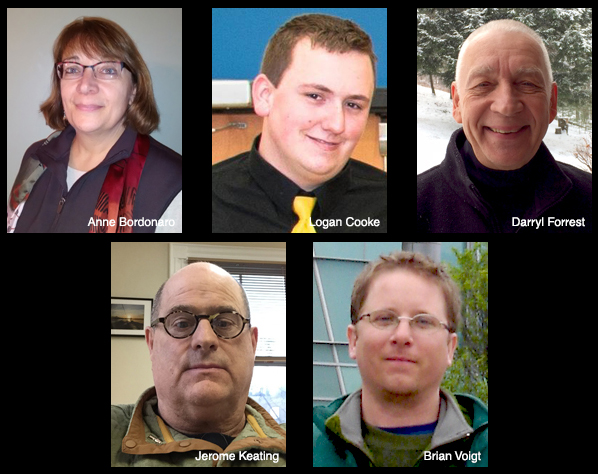At Town Meeting on March 1, Waitsfield voters will elect two townspeople to the select board. There are five people running for the two seats. Logan Cooke, who currently holds a two-year seat on the board, is running for re-election and is being challenged for that seat by Anne Bordonaro and Jerome Keating.
Brian Voigt is seeking a three-year term on the Waitsfield Select Board. Scott Kingsbury, who is not running for re-election, currently holds that term. Darryl Forrest is also running for the three-year term on the board. The Valley Reporter asked the candidates to answer two questions this week. Their answers are below.
VR: If elected, how you will ensure that the Waitsfield town office project stays on budget?
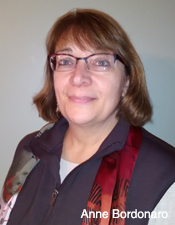 Bordonaro: It was an unfortunate decision not to have hired a clerk of the works to provide oversight of the project initially. Now, it may be necessary to have the contractor provide weekly project updates to the board. If staying within budget is in question, the board should consider further scaling back optional elements of the design (if that is still possible). In general, I am in favor of preserving the small-scale, simple character of our town. I believed from the start that the town office design was overly elaborate and expansive for such a small town with only a few employees. It is most important at this point to finish the job in order to move on to other pressing issues, such as road repairs and finishing the covered bridge. Fortunately, both the builder and architect appear eager to do whatever is necessary to finish the job attractively, appropriately and on budget.
Bordonaro: It was an unfortunate decision not to have hired a clerk of the works to provide oversight of the project initially. Now, it may be necessary to have the contractor provide weekly project updates to the board. If staying within budget is in question, the board should consider further scaling back optional elements of the design (if that is still possible). In general, I am in favor of preserving the small-scale, simple character of our town. I believed from the start that the town office design was overly elaborate and expansive for such a small town with only a few employees. It is most important at this point to finish the job in order to move on to other pressing issues, such as road repairs and finishing the covered bridge. Fortunately, both the builder and architect appear eager to do whatever is necessary to finish the job attractively, appropriately and on budget.
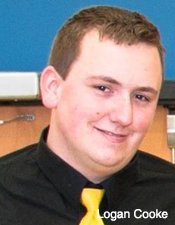 Cooke: The best way to ensure the project finishes on budget is to keep an open line of communication with Millbrook Construction and Maclay Architects. If issues arise that would require change orders, the select board needs to take quick action to reduce or prevent additional cost (which may or may not be inevitable). If we do end up with additional expenses, we need to find ways to save money in other areas. There is some money that could be cut at the end of the project with landscaping and paving that could be adjusted if necessary. In the end, strong oversight by town officials is the best way to keep costs as expected. This includes the select board and the Town Office Committee, of which I am now a part.
Cooke: The best way to ensure the project finishes on budget is to keep an open line of communication with Millbrook Construction and Maclay Architects. If issues arise that would require change orders, the select board needs to take quick action to reduce or prevent additional cost (which may or may not be inevitable). If we do end up with additional expenses, we need to find ways to save money in other areas. There is some money that could be cut at the end of the project with landscaping and paving that could be adjusted if necessary. In the end, strong oversight by town officials is the best way to keep costs as expected. This includes the select board and the Town Office Committee, of which I am now a part.
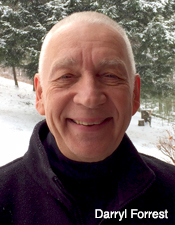 Forrest: On February 11, the town office is 55 percent complete with an estimated completion date of June 20. At the February 22 select board meeting we learned that the project was under budget. As a board member there’s no way to ensure that the office project stays on budget, but I pledge to push back on additional costs that are outside of the contract. Costs for work not included in the contract will be reviewed for approval by the select board. The architect and the contractor have assumed some additional cost because of the incorrect roof height and the contractor is preparing to assume the cost to eliminate the mold. These are the types of problems that have been brought to the town and have been successfully negotiated. With the building 55 percent complete, more additional cost situations may arise. The cost line can be held by improved communications with both the architect and contractor.
Forrest: On February 11, the town office is 55 percent complete with an estimated completion date of June 20. At the February 22 select board meeting we learned that the project was under budget. As a board member there’s no way to ensure that the office project stays on budget, but I pledge to push back on additional costs that are outside of the contract. Costs for work not included in the contract will be reviewed for approval by the select board. The architect and the contractor have assumed some additional cost because of the incorrect roof height and the contractor is preparing to assume the cost to eliminate the mold. These are the types of problems that have been brought to the town and have been successfully negotiated. With the building 55 percent complete, more additional cost situations may arise. The cost line can be held by improved communications with both the architect and contractor.
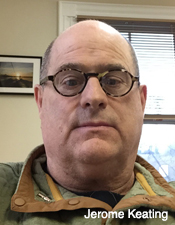 Keating: Unfortunately, I was not part of the original contract negotiations, but it appears that details were overlooked. There is a continuous stream of questions regarding additional work orders and construction errors that constantly need to be addressed. These involve items such as insulation, mold and beam construction just to name a few – all issues that could have been avoided with protections built into the contract. So fast forward to the present as we cannot change what is done. We have to be vigilant and committed to protecting the taxpayers as the project continues. The only way to achieve this commitment is to insist on weekly meetings with both builder and architect with weekly financial updates. Bottom line is that we need to get what we paid for with regard to our new town office.
Keating: Unfortunately, I was not part of the original contract negotiations, but it appears that details were overlooked. There is a continuous stream of questions regarding additional work orders and construction errors that constantly need to be addressed. These involve items such as insulation, mold and beam construction just to name a few – all issues that could have been avoided with protections built into the contract. So fast forward to the present as we cannot change what is done. We have to be vigilant and committed to protecting the taxpayers as the project continues. The only way to achieve this commitment is to insist on weekly meetings with both builder and architect with weekly financial updates. Bottom line is that we need to get what we paid for with regard to our new town office.
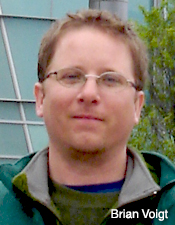 Voigt: The construction of a new town office offers a once-in-a-lifetime opportunity to complete a project that represents the town, now and in the future, in a way that makes us proud. The project architects were hired to serve as the de facto clerk of the works keeping the select board engaged in the project and instilling confidence on the progress. If elected, I’d thoroughly review the progress to date with the project leads, including past expenditures and anticipated deviations from the existing timeline or planned future expenses. I’d use this conversation as an opportunity to look for cost savings while respecting the inertia of the project and working diligently to bring it to a successful conclusion. I’d encourage the board to reflect on lessons learned, consider whether the arrangement with the project architects represents an actual cost savings over hiring an independent clerk of the works and use this experience to better inform future decisions.
Voigt: The construction of a new town office offers a once-in-a-lifetime opportunity to complete a project that represents the town, now and in the future, in a way that makes us proud. The project architects were hired to serve as the de facto clerk of the works keeping the select board engaged in the project and instilling confidence on the progress. If elected, I’d thoroughly review the progress to date with the project leads, including past expenditures and anticipated deviations from the existing timeline or planned future expenses. I’d use this conversation as an opportunity to look for cost savings while respecting the inertia of the project and working diligently to bring it to a successful conclusion. I’d encourage the board to reflect on lessons learned, consider whether the arrangement with the project architects represents an actual cost savings over hiring an independent clerk of the works and use this experience to better inform future decisions.
VR: What are your thoughts about the town's proposed pocket park?
Bordonaro: Like many others, when we voted to approve spending $20,000 for a pocket park, I believed we were voting to protect the space from future development and to extend the already attractive strip of parklike space along the river that the Bridge Street property owners maintain. I expected the monies to go toward removal of the concrete foundation and small-scale improvements, such as planting grass and a shade tree and installing a bench. I never imagined a project of the scale that has been proposed. I don’t like the idea of creating anything involving concrete, nor do I think it is right to spend $200,000 to develop the space, even if it is grant money. Grant monies are not free. We still pay for them through taxes. As I said in my candidacy statement, stewarding what we have is my first priority, including the organic, nondesigned appearance of our town.
Cooke: There are some people who strongly believe in the project. I feel that we need to be very careful in what kind of scale we decide to go with. Regardless of the grant funding, the small area doesn’t lend itself to a lot of uses and we don’t want to build something that is out of character with the area. We also don’t want to spend more than the space is worth. Parks are a great community asset. However, ones of that size and location don’t have as much of a long-term benefit to the entire community. With all of that being said, the overwhelming support of the project during Town Meeting last year means the select board needs to do our best to make sure the project moves forward in an appropriate, prudent way. Community involvement moving forward will be crucial.
Forrest: The town office and pocket park are what I encountered most while campaigning. What I heard included:
• Why spend so much money on a pocket park when there are other more important things?
• Do something to improve the space, but don’t spend so much money.
• The select board is nuts to consider spending on this piece of land. I don’t care if it’s a 90 percent funded grant, it still costs us money.
I tend to side with a less costly fix. In the proposed park area the raised bridge approach makes it harder to access the path along the site. Repairing the damaged foundation wall, cleaning up the area and providing a better approach to the foundation floor from the southwest would create a viewing area without the ramifications of the flood plain restrictions. The area needs work to make it presentable and I would support a fix at a cost that is more tolerable to taxpayers.
Keating: I do not want the pocket park to grow into another project that becomes a bureaucratic nightmare and financial liability for the town. We can have a beautiful and green pocket park for approximately $5,000 versus $180,000. Many in the community have offered viable solutions for a cost-effective way to create a welcoming space that mirrors the authenticity of the Mad River Valley and I intend to act on those solutions.
Voigt: The course of this project has become standard operating procedure for Waitsfield. Voters approve an expenditure at Town Meeting. The select board proceeds reluctantly. Naysayers sow seeds of doubt. Prolonged, circuitous conversations across multiple meetings obscure the facts. The opportunity for meaningful dialogue, a shared sense of ownership and compromise falls by the wayside. We should use this project as an opportunity to establish a more inclusive standard for public discourse and shared decision making. The skills I bring to the table, including my respect for a diversity of opinions, can help make this possible. I’d like to see a park design that compliments the Bridge Street vernacular, provides safe public access for all levels of mobility and serves as both a historical marker of the impact of Tropical Storm Irene and an educational showcase reminding us of the awesome power of nature and why we should respect the river and its floodways when planning for future development.


